-
1. d4, d5
2. Nf3, e6
3. e3!?
Modern theory might suggest 3 c4 immediately heading to a Queens Gambit Declined.
3...c5
4. c4, Nc6
5. Nc3, Nf6
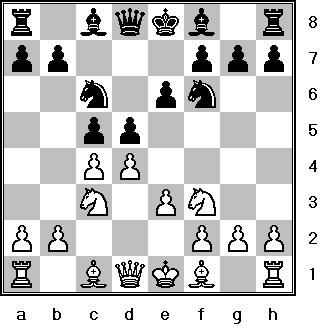
We have reached a Queens Gambit Declined; Semi-Tarrasch variation by transposition of moves.
6. dxc5?!
Premature. Better is 6. a3! the modern move, when after 6...a6 7. dxc5, Bxc5 8. b4, Ba7 9. Bb2, 0-0 10. Qc2, Qe7 with approximate equality. Also If 6.cxd5 exd5; 7.g3!? would reach lines similar to the pure Tarrasch Defense where black stands well as white has hemmed in his dark squared bishop by e3.
6...Bxc5
7. a3, a6
8. b4, Bd6!

Aggressive piece placement. Black is willing to sacrifice a pawn for the intiative. White cannot accept. Notice 9. cxd5!?, exd5 10. Nxd5, Nxd5 11. Qxd5?? is refuted by 11...Bxb4+ winning the White Queen.
9. Bb2
A standard development for Whites bishop in the Semi-Tarrasch.
9...0-0
10. Qd2?!
This move is not well thought out as the Queen will be a target on the open d-file. Best was 10. Qc2.
10...Qe7!

The Queen development by black is flexible and also continues to offer a pawn. Again the capture is risky if 11. cxd5, exd5 12. Nxd5, Nxd5 13. Qxd5, Be6 14. Qd1 (on 14. Qg5, Bxb4+! wins at once) 14...Nxb4! and black has much the best of it--Irving Chernev.
11. Bd3?!
This loses Tempi and has been duly criticized. White had 2 alternatives:
a) 11. 11.cxd5!? exd5; 12.Nxd5, Nxd5; 13.Qxd5, Rd8! -Soltis. Black has tremendous compensation for the pawn, the intiative, a lead in development and open lines for an attack.
b) 11.c5!? Bc7 12.Be2 Rd8 13.0-0 e5 with an edge to black.
In view of the above lines Whites play isnt the horrible move made out by modern Grandmasters, one must remember this game was played nearly 100 years ago when theory was not so well developed and loss of a tempo was not considered the death knell. It is this very concept that Rubinstein demonstrates. With White's first loss of time he equalizes and with his second loss of time black gains the advantage and plays for a brilliant, devastating, yet logical attack.
11...dxc4
12. Bxc4, b5
13. Bd3
Trying to block the d-file.
13...Rd8
14. Qe2
The unhappy Queen moves off the d-file to avoid tactical discoveries.
The Russian master Romanovsky wrote: "It is now clear that the 4 moves used by White to place his bishop on d3, and his Queen on e2 means the loss of 2 tempos. This leads to his defeat."
14...Bb7
15. 0-0, Ne5!

The position was very symmetrical where black had gained a couple of extra tempi. Now Black breaks the symmetry with various threats e.g. he threatens 16...Nxd3 and if 17. Qxd3, Bxh2+! wins the White Queen.
16. Nxe5
Practically forced, but White parts with his king knight the best defender of his castled position.
16...Bxe5
Black now threatens to win a pawn by 17...Bxh2+! 18. Kxh2, Qd6+ and 19...Qxd3.
17. f4
White is worried about the h2-b8 diagnol as shown in the above line under blacks 16th move and so blocks it off.
17...Bc7
18. e4?
This is ill-advised. The opening of lines favors the attacker. White should have played the tough defensive move18. Rfd1! as given by Hans Kmoch when white has some chances of holding the game.
18...Rac8

At a glance the position may appear to be about equal but black is a couple tempi ahead and whites rooks have not yet moved.
"Rubinstein brings up the reserves. This sort of move always reminds me of Blackburne's advice, 'Never commence your final attack until your QR is in play.' - Irving Chernev.
19. e5!?
Again we see Rotlewi is most concerned about the h2-b8 diagnol and plays to keep it closed, the drawback is that he weakens the long diagnol. "Better was 19. Rac1" -Soltis
19...Bb6+
Locked out on the h2-b8 diagnol he gains a new strong diagnol with gain of time.
20. Kh1, Ng4!!
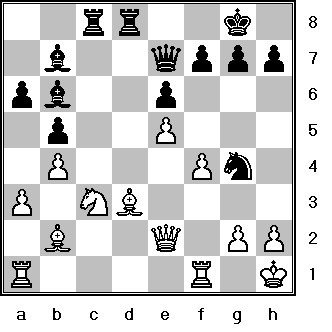
Black unleashes an awesome attack!
White probably expected 20...Nd5 when he has a probable draw, for example 21. Nxd5, Bxd5 22. Rfc1, Rxc1+ 23. Rxc1, Qh4 24. Rf1 blacks pieces are more active but White might hold with proper defense.
21. Be4
White tries to exchange off one of the terrifying bishops and block the long diagnol.
If instead white plays 21. Ne4 black has 21...Rxd3! 22. Qxd3, Bxe4 23. Qxe4, Qh4! (threatens mate on move) 24. h3, Qg3 (again threatens mate on move) 25. hxg4, Qh4#
21...Qh4!
Chernev writes: "Rubinstein begins the display of fireworks."
22. g3
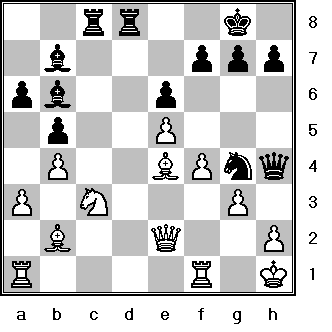
Now black appears to have hit a wall in his attack he is threatened by both loss of Queen by gxh4 and loss of Bishop with Bxb7.
22...Rxc3!!!
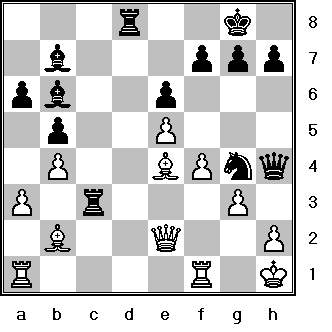
"Kmoch adorns this beautful move with 3 exclamation marks, I can give it no less"- Chernev.
One of the most profound moves ever played on a chess board. A truely shocking move that forces a mating sequence.
23. gxh4
What choice is there? If 23. Bxc3, Bxe4+ 24. Rf3, Bxf3+ 25. Qxf3, Qxh2# Or if 23. Bxb7, Rxg3! and the threat of 24...Nxh2 25. Qxh2, Rh3 is decisive.-Chernev.
23...Rd2!!

WOWZA. Another superb tactical shot. Black uses a decoy sacrifice to lure the White Queen away from the defense of the Be4. This startling rook move leaves 4 of blacks 5 pieces "en prise". Amazing!!
24. Qxd2
White had a bewildering choice of losing moves:
- a) 24. Bxb7, Rxe2 25. Bg2, Rh3! and mate to follow.
- b) 24. Bxc3, Rxe2 and white cannot parry the threats of mate in one by the rook and mate in two by the bishop.
- c) 24. Qxg4, Bxe4+ 25. Rf3, Rxf3 26. Qg2 (threat was Rf1++#), Rf1+ 27. Rxf1, Bxg2#
24...Bxe4+
25. Qg2
The only legal move.
25...Rh3!
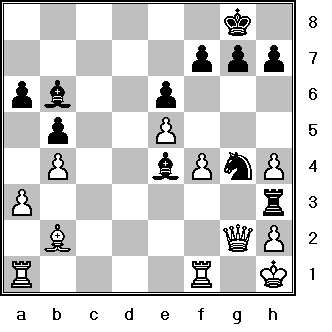
Rubinstein ends the game with a final master-stroke.
White resigned as mate cannot be averted.
0-1
Tactical Themes: Decoy, Piece exploitation, Removing the defender, Enticement, Pin
Mating Themes: 2 Bishop Mate, Knight and Rook Mate, Missing f-pawn Mate, Arabian Mate.
I consider this the 2nd Greatest Attacking Game of All Time